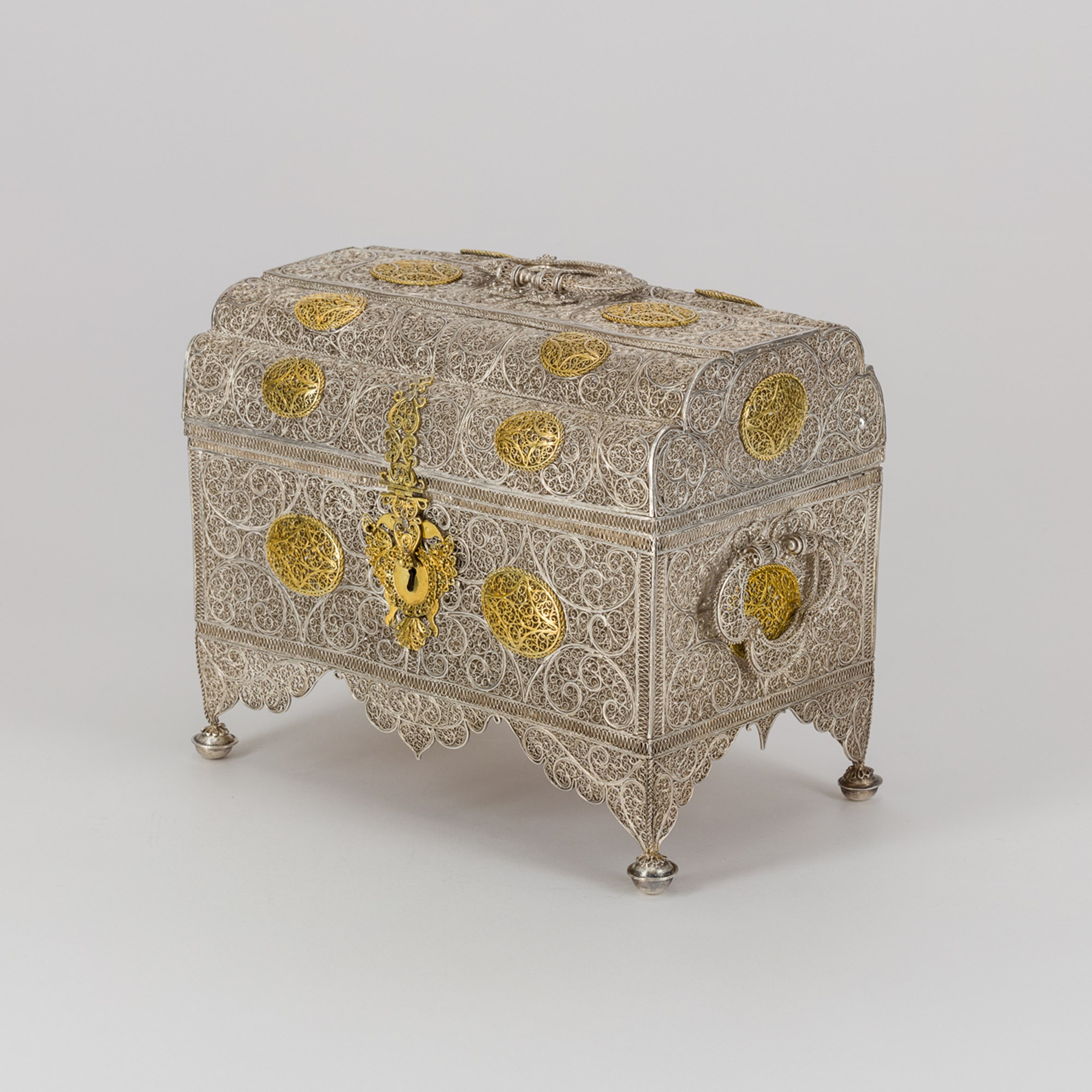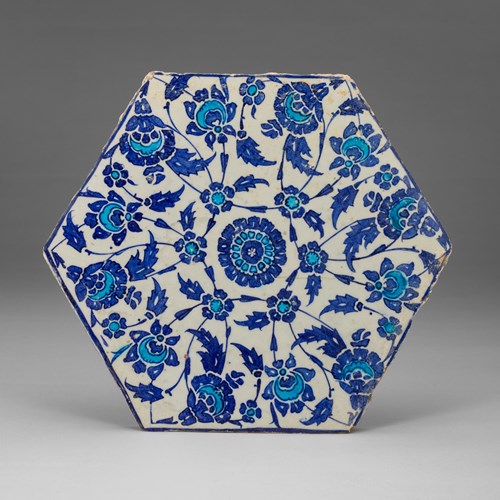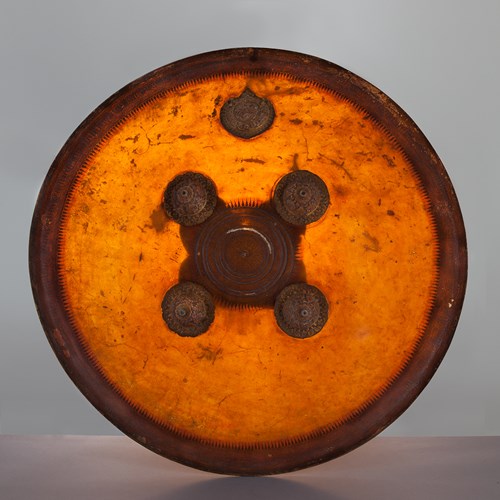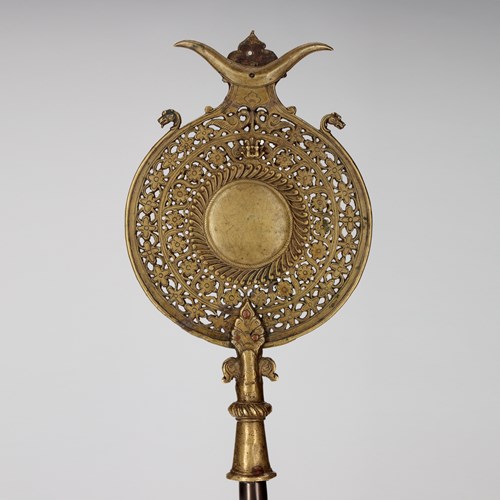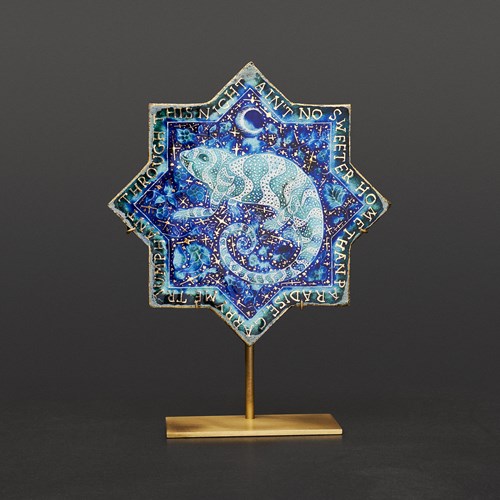Marketplace
Silver Filigree Casket
Silver Filigree Casket
Epoque 17th century
Origine The Philippines
Medium silver
Dimension 21 x 25 x 16 cm (8¹/₄ x 9⁷/₈ x 6¹/₄ inches)
Made for the Iberian and South American markets
This large silver filigree casket has a rectangular box and a trilobate, and a fluted lid that raises from a bracket socle; the casket is set on ball-shaped feet. Featuring two scalloped trilobate handles on the sides and a similar third one on top, it has a large, imposing lock plate with a raised circular escutcheon in the centre with a side latch hinged to the lid. The lock, like the raised oval medallions decorating the exterior faces of the box and lid, is made from gilt silver filigree in contrast with the white silver of the casket. The lock features a raised oval box for the key and is set on an escutcheon profiled like a double-headed eagle, a common design in objects made in the Philippines for the Iberian and South American markets. The filigree decoration consists of rectangular panels, separated by serpentine borders, which are filled with four kidney-shaped elements each set in two-fold symmetry. Following the characteristic stylistic features of this production, the filigree design makes use of a very thick square-section wire for the main motif, in contrast with the subtle flattened twisted wires that are used in the filigree filling. The weight is also a characteristic feature of this production, contrasting with lightweight pieces made later in India.1 Although the source for the shape of the lid is hard to identify, the overall shape of the casket, with its bracket socle is certainly Chinese in origin, such as small chests for storing documents and valuables set with flat lids known as xiaoxiang and seal boxes with bevelled or canted lids known as yinxia.2 While large caskets similarly made for export in the Philippines exist in public and private collections, the presence of applied gilt silver elements, such as those on the present example, is less frequent.
The fine silver filigree design of this casket is typical of the Philippines, albeit made according to Chinese techniques and style probably by Chinese or mestizo craftsmen working in Manila. Similar pieces in design and decoration were recovered from the shipwreck of the Manila galleon, Nuestra Señora de la Concepción, which went down on 20 September 1638 off the Mariana Islands while bound for Acapulco, Mexico.3 The ‘treasure’, found, duly recorded and studied but unfortunately poorly known, contains several pieces of gold filigree of the highest artistic and technical merits, undoubtedly transported as a commodity and all produced for export given the sheer number of surviving pieces. The recurrent features in the filigree jewellery found there, while indicating the same workshop, do not enable us to determine their exact origin. Similar piecesbrought by junk sailing from Guangzhou (Canton) in Guangdong province, Quanzhou or Fuzhou in Fujian province, were made in southern China or Manila, the likely production centre of our piece. The stylistic features present in these valuable pieces are serpentine friezes; friezes decorated with ‘s’ motifs with coiled ends forming an ‘o’, which is deemed quintessentially Chinese; and pentagonal rosettes formed of wire with a granule at the centre, an exclusive feature of Chinese-style filigree. Such features as seen on the present casket, alongside its shape and the double-headed eagle on the lock, help us to identify its centre of production with the Philippines. Similarly shaped caskets, with identical decoration, together with other objects identified with certainty with this production centre, have recently been published, including a perfume flask made from a carved pili nut (Canarium ovatum), a species indigenous to the Philippine archipelago, with silver filigree mounts similar in design to those occurring on the present casket.4 According to its carved inscription, the flask was commissioned by Don Baltasar Ruiz de Escalona, Treasurer Judge of the Royal Treasury of the Philippines who died in Manila in 1658.
Footnotes:
1. See Crespo 2015, p. 135
2. See Crespo 2021, p. 15
3. See Chadour 1990; and Crespo 2015, pp. 102–103
4. See Crespo 2016, pp. 366–381, cat. 32
References:
Chadour, A. B. ‘The gold jewelry from the Nuestra Señora de la Concepción’, in Mathers, W. M., Parker H. S. and Copus, K. (eds.). Archaeological Report. The Recovery of the Manila Galleon Nuestra Señora de la Concepción, Sutton, Pacific Sea Resources, 1990, pp. 133–395.
Crespo, H. M. Jewels from the India Run (cat.), Lisboa, Fundação Oriente, 2015.
Crespo, H. M. Choices, Lisboa, AR-PAB, 2016.
Crespo, H. M. India in Portugal: A Time of Artistic Confluence (cat.), Porto, Bluebook, 2021.
Mathers, W. and Shaw, N. Treasure of the Concepción. The Archaeological Recovery of a Spanish Galleon, Annapolis, APA Publications (HK) Ltd, 1993.
Stock No.: A5286
This large silver filigree casket has a rectangular box and a trilobate, and a fluted lid that raises from a bracket socle; the casket is set on ball-shaped feet. Featuring two scalloped trilobate handles on the sides and a similar third one on top, it has a large, imposing lock plate with a raised circular escutcheon in the centre with a side latch hinged to the lid. The lock, like the raised oval medallions decorating the exterior faces of the box and lid, is made from gilt silver filigree in contrast with the white silver of the casket. The lock features a raised oval box for the key and is set on an escutcheon profiled like a double-headed eagle, a common design in objects made in the Philippines for the Iberian and South American markets. The filigree decoration consists of rectangular panels, separated by serpentine borders, which are filled with four kidney-shaped elements each set in two-fold symmetry. Following the characteristic stylistic features of this production, the filigree design makes use of a very thick square-section wire for the main motif, in contrast with the subtle flattened twisted wires that are used in the filigree filling. The weight is also a characteristic feature of this production, contrasting with lightweight pieces made later in India.1 Although the source for the shape of the lid is hard to identify, the overall shape of the casket, with its bracket socle is certainly Chinese in origin, such as small chests for storing documents and valuables set with flat lids known as xiaoxiang and seal boxes with bevelled or canted lids known as yinxia.2 While large caskets similarly made for export in the Philippines exist in public and private collections, the presence of applied gilt silver elements, such as those on the present example, is less frequent.
The fine silver filigree design of this casket is typical of the Philippines, albeit made according to Chinese techniques and style probably by Chinese or mestizo craftsmen working in Manila. Similar pieces in design and decoration were recovered from the shipwreck of the Manila galleon, Nuestra Señora de la Concepción, which went down on 20 September 1638 off the Mariana Islands while bound for Acapulco, Mexico.3 The ‘treasure’, found, duly recorded and studied but unfortunately poorly known, contains several pieces of gold filigree of the highest artistic and technical merits, undoubtedly transported as a commodity and all produced for export given the sheer number of surviving pieces. The recurrent features in the filigree jewellery found there, while indicating the same workshop, do not enable us to determine their exact origin. Similar piecesbrought by junk sailing from Guangzhou (Canton) in Guangdong province, Quanzhou or Fuzhou in Fujian province, were made in southern China or Manila, the likely production centre of our piece. The stylistic features present in these valuable pieces are serpentine friezes; friezes decorated with ‘s’ motifs with coiled ends forming an ‘o’, which is deemed quintessentially Chinese; and pentagonal rosettes formed of wire with a granule at the centre, an exclusive feature of Chinese-style filigree. Such features as seen on the present casket, alongside its shape and the double-headed eagle on the lock, help us to identify its centre of production with the Philippines. Similarly shaped caskets, with identical decoration, together with other objects identified with certainty with this production centre, have recently been published, including a perfume flask made from a carved pili nut (Canarium ovatum), a species indigenous to the Philippine archipelago, with silver filigree mounts similar in design to those occurring on the present casket.4 According to its carved inscription, the flask was commissioned by Don Baltasar Ruiz de Escalona, Treasurer Judge of the Royal Treasury of the Philippines who died in Manila in 1658.
Footnotes:
1. See Crespo 2015, p. 135
2. See Crespo 2021, p. 15
3. See Chadour 1990; and Crespo 2015, pp. 102–103
4. See Crespo 2016, pp. 366–381, cat. 32
References:
Chadour, A. B. ‘The gold jewelry from the Nuestra Señora de la Concepción’, in Mathers, W. M., Parker H. S. and Copus, K. (eds.). Archaeological Report. The Recovery of the Manila Galleon Nuestra Señora de la Concepción, Sutton, Pacific Sea Resources, 1990, pp. 133–395.
Crespo, H. M. Jewels from the India Run (cat.), Lisboa, Fundação Oriente, 2015.
Crespo, H. M. Choices, Lisboa, AR-PAB, 2016.
Crespo, H. M. India in Portugal: A Time of Artistic Confluence (cat.), Porto, Bluebook, 2021.
Mathers, W. and Shaw, N. Treasure of the Concepción. The Archaeological Recovery of a Spanish Galleon, Annapolis, APA Publications (HK) Ltd, 1993.
Stock No.: A5286
Epoque: 17th century
Origine: The Philippines
Medium: silver
Dimension: 21 x 25 x 16 cm (8¹/₄ x 9⁷/₈ x 6¹/₄ inches)
Provenance: From the collection of a prominent Belgian princely family
Plus d'œuvres d'art de la Galerie


